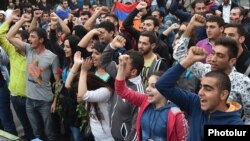A loss-making power distribution company that has sought and achieved an increase in socially sensitive electricity prices thus sparking large-scale street protests in Armenia appears to have made lavish donations to private foundations, including those set up by Armenia’s senior officials.
It has emerged lately that over the past several years Russian Inter RAO’s Armenian subsidiary, Electric Networks of Armenia (ENA), has donated more than $10 million to an education promoting fund set up and managed by incumbent President Serzh Sarkisian and former Prime Minister Tigran Sarkisian.
Meanwhile, in the period of 2010-2014, the ENA reported losses amounting to more than $33.5 million.
The ENA cited losses in grounding its bid earlier this year to have the current electricity tariffs raised by some 40 percent. The Armenian tariff-setting commission eventually approved the rise by only some 16 percent, but even following that decision thousands of Armenian took to the streets last month and stayed put in capital Yerevan’s central boulevard for nearly two weeks, forcing the government to announce a full subsidy of the price hike effective on August 1 as well as an impending audit of the ENA to establish how far the tariff rise is justified.
The ENA acknowledges having made donations to private funds, but it says the money has been provided as part of the company’s social responsibility policy. It argues that it is the increasing cost of energy produced by Armenia’s power-generating companies as well as the nearly 20-percent depreciation of the Armenian national currency last year that are the main factors accounting for the company’s losses.
ENA managers also deny that spending on alleged “luxury” cars and apartments in Yerevan has had any significant influence on the financial situation of the company.
Meanwhile, some in Armenia see corruption risks in ENA donations to organizations linked with government officials.
Artak Manukian, an expert with the Transparency International anti-corruption center, describes such donations as at least “odd”.
“It is strange that the ENA has not received from the government the privileges on the payment of profit tax in the amount of its charity, something which is applied in the case of other organizations that make donations and which is also an incentive to these companies to make these donation,” the expert observes.
The Luys Foundation that has benefited from ENA donations listed the power-distribution company as its largest sponsor in the 2014 report. But the foundation’s official website does not have a mention about this fact today.
Representatives of the foundation that pays for tuition fees of talented Armenian students in prestigious universities abroad have declined to answer questions from RFE/RL’s Armenian Service immediately. One of Luys executives said she would answer questions only in a live show on RFE/RL’s internet-based Azatutyun TV.





